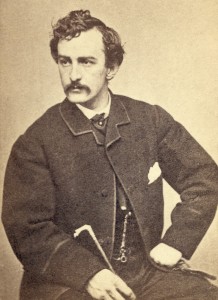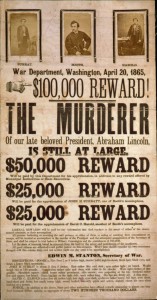by Jack El-Hai, Wonders & Marvels contributor
Admit it — if you’re following this blog, you believe that reading something especially intriguing can transport you through an unexpected window of history. I have that experience almost every time I browse FBI files on notable people and events.
Over the years, in response to Freedom of Information Act requests, the FBI has publicly released its files on a marvelous assortment of deceased people of celebrity, infamy, and importance. On my personal blog, I’ve written about the FBI file on the actress Carole Lombard and the agency’s investigation of the World War II air crash that killed her, as well as the file on architect Frank Lloyd Wright and his tangles with the government.
These files reveal as much about the worldview and techniques of the FBI as they do of the lives of their subjects.
I recently learned that John Wilkes Booth, who assassinated Abraham Lincoln in 1865, is the subject of another bulky FBI file, which is surprising because the FBI did not come into existence until six decades after Booth’s crime and death. What could possibly be in a file compiled so long after Lincoln’s assassination?
Did Booth elude capture?
The oldest pages of the file discuss the possibility that Booth escaped capture after he shot Lincoln. A Missourian who wrote to Bureau of Investigation director William J. Burns in 1922 claimed that his neighbor either was Booth or was in correspondence with the assassin. Burns replied skeptically that the agency was “inclined to believe official records in the case of John Wilkes Booth, and do[es] not feel that any investigation is necessary” to follow up.
Yet the following year, when another letter writer suggested that Burns read a book promoting a theory that Booth successfully fled his captors, the director seemed to have changed his mind. “The work contains very strong evidence in support of the old belief that Booth did escape and live many years after the assassination of President Lincoln,” Burns wrote. Was the agency’s director really among the believers? The file offers no further details.
The FBI gets the boot
The agency’s next encounter with Booth, as documented in the file, came in 1948, when the superintendent of the National Park Service’s U.S. capital properties sent the FBI an odd artifact in his charge: a boot that Booth was wearing when Dr. Samuel Mudd treated the left leg that the fugitive injured when he leapt from a theater balcony after shooting the president. Inside the boot was some faint writing. Could the FBI’s experts make out what it said?
The short answer, laid out in a report that director J. Edgar Hoover prefaced and signed, was that despite examining the boot’s interior with ultraviolet and infrared light, the FBI could not determine what the writing said beyond giving the name of the boot maker. The agency then returned the boot, and it currently is on display in the Ford’s Theatre Museum in Washington.
Diary of an Assassin
Most of the FBI’s file on Booth concerns an analysis of a pocket diary that Booth carried with him when he was tracked down and killed in 1865. In 1977, yet another administrator with the National Park Service’s National Capital properties asked the FBI to examine this little book “in order to rest any question about the possibility of invisible writing in the diary,” he wrote. (The concerns of the Park Service grew from the release that same year of The Lincoln Conspiracy, a film that alleged the secret involvement of Secretary of War Edwin Stanton in the president’s death.) In addition, the Park Service hoped that the FBI would authenticate Booth’s handwriting by comparing the handscript in the diary with the handwriting in letters known to have been composed by Booth.
The FBI exposed the historical artifact to a variety of light frequencies, including ultraviolet, fluorescence with ultraviolet excitation, infrared, and x-ray. No hidden notations appeared. The agency judged the handwriting to be Booth’s and also confirmed that 27 sheets were missing from the diary. The absence of these pages had been known since 1867.
Unfortunately, Washington newspaper columnist Jack Anderson erroneously reported that the FBI was also analyzing these previously missing pages. The FBI denied having them, and the pages have never turned up. The diary itself, however, is currently exhibited at the Ford’s Theatre Museum.
That’s plenty of investigative intrigue for one file.
Further reading:
Anderson, Jack. “Lincoln Assassination Probed.” August 4, 1977.
Federal Bureau of Investigation. File on John Wilkes Booth.


